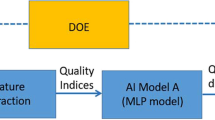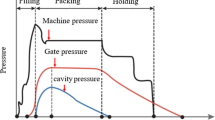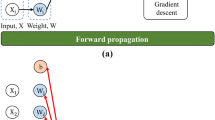Abstract
Injection molding has been broadly used in the mass production of plastic parts and must meet the requirements of efficiency and quality consistency. Machine learning can effectively predict the quality of injection-molded part. However, the performance of machine learning models largely depends on the accuracy of the training. Hyperparameters such as activation functions, momentum, and learning rate are crucial to the accuracy and efficiency of model training. This research aims to analyze the influence of hyperparameters on testing accuracy, explore the corresponding optimal learning rate, and provide the optimal training model for predicting the quality of injection-molded parts. In this study, stochastic gradient descent (SGD) and stochastic gradient descent with momentum (SGDM) are used to optimize the artificial neural network model. Through optimization of these training model hyperparameters, the width testing accuracy of the injection product is improved. The experimental results indicate that in the absence of momentum effects, all five activation functions can achieve more than 90% of the training accuracy with a learning rate of 0.1. Moreover, when optimized with the SGD, the learning rate of the Sigmoid activation function is 0.1, and the testing accuracy reaches 95.8%. Although momentum has the least influence on accuracy, it affects the convergence speed of the Sigmoid function, which reduces the number of required learning iterations (82.4% reduction rate). In summary, optimizing hyperparameter settings can improve the accuracy of model testing and markedly reduce training time.














Similar content being viewed by others
Data availability
The authors confirm that the data supporting the findings of this study are available within the article.
References
Huang MS, Ke KC, Liu CY (2021) Cavity pressure-based holding pressure adjustment for enhancing the consistency of injection molding quality. J Appl Polym Sci 138(50357):1–10
Zhang J, Zhao P, Zhao Y, Huang J, Xia N, Fu J (2019) On-line measurement of cavity pressure during injection molding via ultrasonic investigation of tie bar. Sens Actuators Phys 285:118–126
Lin CC, Wang WT, Kuo CC, Wu CL (2014) Experimental and theoretical study of melt viscosity in injection process. Int J Mech Mecha Eng 8:1–5
Wang J, Peng J, Yang W (2011) Filling-to-packing switchover mode based on cavity temperature for injection molding. Polym-Plast Technol Eng 50:1273–1280
Zhao P, Xia N, Zhang J, Xie J, Zhang C, Fu J (2020) Measurement of molecular orientation using longitudinal ultrasound and its first application in in-situ characterization. Polymer 187(122092):1–11
Farahani S, Brown N, Loftis J, Krick C, Pichl F, Vaculik R, Pilla S (2019) Evaluation of in-mold sensors and machine data towards enhancing product quality and process monitoring via Industry 4.0. Int J Adv Manuf Technol 105:1371–1389
Loftis J, Farahani S, Pilla S (2020) Online quality monitoring of plastic parts using real-time data from an injection molding machine. Inter Manuf Sci Eng Conf, ASME 84256:V001T02A001
Chang YH, Wei TH, Chen SC, Lou YF (2020) The investigation on PVT control method establishment for scientific injection molding parameter setting and its quality control. Polym Eng Sci 60:2895–2907
Wang J (2012) PVT properties of polymers for injection molding. Some Critical Issues for Injection Molding 1–30
Hopmann C, Kahve C, Schmitz M (2020) Development of a novel control strategy for a highly segmented injection mold tempering for inline part warpage control. Polym Eng Sci 60:2428–2438
Wang J, Mao Q (2013) A novel process control methodology based on the PVT behavior of polymer for injection molding. Adv Polym Technol 32:E474–E485
Kamaruddin S, Khan ZA, Foong SH (2010) Application of Taguchi method in the optimization of injection moulding parameters for manufacturing products from plastic blend. Int J Eng Technol 2:574–580
Yizong T, Ariff ZM, Khalil AM (2017) Influence of processing parameters on injection molded polystyrene using Taguchi method as design of experiment. Procedia Eng 184:350–359
Kiatcharoenpol T, Vichiraprasert T (2018) Optimizing and modeling for plastic injection molding process using Taguchi method. J Phys Conf Ser 1026:012018
Wang Q, Yang C, Du K, Wu Z (2019) Effect of micro injection molding parameters on cavity pressure and temperature assisted by Taguchi method. Mechanika 25:261–268
Feng Q, Liu L, Zhou X (2020) Automated multi-objective optimization for thin-walled plastic products using Taguchi, ANOVA, and hybrid ANN-MOGA. Int J Adv Manuf Technol 106:559–575
Lockner Y, Hopmann C (2021) Induced network-based transfer learning in injection molding for process modelling and optimization with artificial neural networks. Int J Adv Manuf Technol 112:3501–3513
Ke KC, Huang MS (2020) Quality prediction for injection molding by using a multilayer perceptron neural network. Polymers 12:1812
Ke KC, Huang MS (2021) Quality classification of injection-molded components by using quality indices, grading, and machine learning. Polymers 13:353
Hwang S, Kim J (2019) Injection mold design of reverse engineering using injection molding analysis and machine learning. J Mech Sci Technol 33:3803–3812
Ogorodnyk O, Lyngstad OV, Larsen M, Wang K, Martinsen K (2019) Application of machine learning methods for prediction of parts quality in thermoplastics injection molding. Advanced Manufacturing and Automation VIII. Springer, Singapore, pp 237–244
Lei Y, Tang K (2021) Learning rates for stochastic gradient descent with nonconvex objectives. IEEE Trans Pattern Ana Mach Intell. https://doi.org/10.1109/TPAMI.2021.3068154
Cheridito P, Jentzen A, Rossmannek F (2021) Non-convergence of stochastic gradient descent in the training of deep neural networks. J Complex 64:101540
Jin R, He X (2020) Convergence of momentum-based stochastic gradient descent. 16th IEEE Int Conf Control Automation, Sapporo, Hokkaido, Japan, pp 779–784
Sharma A (2018) Guided stochastic gradient descent algorithm for inconsistent datasets. Appl Soft Comput J 73:1068–1080
Gupta P, Garg S (2019) Breast cancer prediction using varying parameters of machine learning models. 3rd Int Conf Computing Network Communications, Trivandrum, Kerala, India, pp 593–601
Bock S, Weis M (2019) A proof of local convergence for the Adam optimizer. Int Joint Conf Neural Networks, Institute of Electrical and Electronics Engineers Inc., Budapest, Hungary
Hochreiter S (1998) The vanishing gradient problem during learning recurrent neural nets and problem solutions”. Int J Uncertain Fuzziness Knowledge-Based Syst 6:107–116
Bjorck J, Gomes C, Selman B, Weinberger KQ (2018) Understanding batch normalization. ArXiv180602375 Cs Stat
Acknowledgements
This research was supported in part by the Frontier Mould and Die Research and Development Center from The Featured Areas Research Center Program within the framework of the Higher Education Sprout Project by the Ministry of Education (MOE), Taiwan.
Author information
Authors and Affiliations
Contributions
K.-C. Ke and M.-S. Huang were responsible for deriving formulas. K.-C. Ke was responsible for simulation. K.-C. Ke and M.-S. Huang were involved in the discussion and significantly contributed to making the final draft of the article. All the authors read and approved the final manuscript.
Corresponding author
Ethics declarations
Consent to participate
Not applicable.
Consent to publish
Not applicable.
Competing interests
The authors declare no competing interests.
Ethical approval
Not applicable.
Additional information
Publisher's Note
Springer Nature remains neutral with regard to jurisdictional claims in published maps and institutional affiliations.
Rights and permissions
About this article
Cite this article
Ke, KC., Huang, MS. Enhancement of multilayer perceptron model training accuracy through the optimization of hyperparameters: a case study of the quality prediction of injection-molded parts. Int J Adv Manuf Technol 118, 2247–2263 (2022). https://doi.org/10.1007/s00170-021-08109-9
Received:
Accepted:
Published:
Issue Date:
DOI: https://doi.org/10.1007/s00170-021-08109-9




